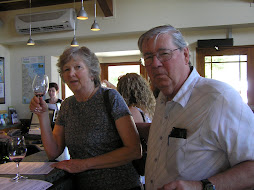




Clara and I made our first visit to Toppenish, WA on Aug. 6, 1999 while on a trip from Las Vegas to Seattle (to visit Lesley and then one-year-old baby Leo) with major stops along the way in Montana to visit Clara's nephews and to spend time at Glacier Nat'l Park.
The small town of Toppenish, WA is well known to us for three reasons:
1) It is home to the Cultural Heritage Center of the Yakama Nation (yes, I've spelled it correctly according to the Native Americans), which includes among other things a nice RV park -- also a museum, restaurant, theater, and, a few blocks walk away, a casino.
2) It provides a nice home base for touring the Yakima Valley -- its wineries and fruit stands.
3) It has a marvelous group of murals, some 80 in all, created to depict the history and stories of the region between 1850 and 1950.
This first picture is Toppenish's first Mural-in-a-Day, painted on June 3, 1989, to launch the ambitious mural program. Designed by Phil Kooser of Yakima, the mural was painted under his direction by 15 noted western artists who collaborated on the 40-foot painting on the side of the Western Auto building at Washington Ave. and Toppenish Ave. It depicts the tremendous effort put forth by settlers in the area.
Each year, during the first week in June, another "Mural-in-a-Day" is added to the collection -- you're welcome to come and watch it being done. In addition, you can take a motorized, guided tour of the 80 murals all over town. Here are a few of them (the pictures don't really show the size of the murals -- they're painted on the sides of buildings, many feet high, even more feet long -- truly a sight to see.)















































